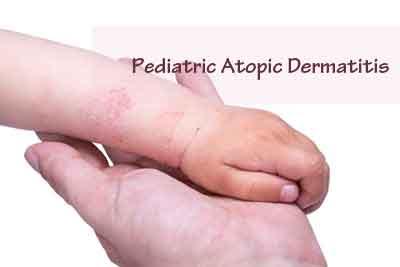- Home
- Editorial
- News
- Practice Guidelines
- Anesthesiology Guidelines
- Cancer Guidelines
- Cardiac Sciences Guidelines
- Critical Care Guidelines
- Dentistry Guidelines
- Dermatology Guidelines
- Diabetes and Endo Guidelines
- Diagnostics Guidelines
- ENT Guidelines
- Featured Practice Guidelines
- Gastroenterology Guidelines
- Geriatrics Guidelines
- Medicine Guidelines
- Nephrology Guidelines
- Neurosciences Guidelines
- Obs and Gynae Guidelines
- Ophthalmology Guidelines
- Orthopaedics Guidelines
- Paediatrics Guidelines
- Psychiatry Guidelines
- Pulmonology Guidelines
- Radiology Guidelines
- Surgery Guidelines
- Urology Guidelines
Pediatric atopic dermatitis may benefit from early immune intervention

An association between pediatric eczema and large abnormalities in non-lesional skin and multi T lymphocyte axes activation has been uncovered by researchers.
New York : Researchers for the first time have identified the skin phenotype of pediatric eczema or atopic dermatitis (AD) in infants, opening the door for personalized treatment approaches for young children with eczema. The study, led by researchers at the Icahn School of Medicine at Mount Sinai and Northwestern University’s Feinberg School of Medicine, was published online in the Journal of Allergy and Clinical Immunology.
Emma Guttman-Yassky, MD, PhD, Professor of Dermatology and Immunology, and Vice Chair of the Department of Dermatology at the Icahn School of Medicine, and Amy S. Paller, MD, Walter J. Hamlin Professor and Chair of the Department of Dermatology at Northwestern, investigated lesional and non-lesional skin biopsies from 19 AD infants under the age of five, and compared them to age-matched pediatric controls, in addition to adult AD biopsies. The researchers found that the non-lesional, or normal-appearing, skin of young children with early eczema is already highly abnormal with significant immune activation, simulating that of lesional skin of adults with many years of active disease.
“The important findings may suggest the need for early immune intervention at a young age, not only to treat the eczema but perhaps also to prevent other allergic diseases (such as asthma, food allergies, seasonal allergies which usually follow the development of research on AD focuses on the mechanism of the underlying disease and promotes development of targeted therapeutics. Her past research has identified biomarkers for current treatments for AD.
The study also highlighted some important differences between the adult and pediatric phenotypes. First, the research showed that pediatric AD is associated with increased lymphocyte activation, including Th2 lymphocyte cells, which is also similar to adults with AD. Next, the researchers discovered that that unlike the adult disease, the pediatric eczema profile has robust and significant increases of Th17 T lymphocyte cells, which are characteristically increased in psoriasis, a disease that is now being successfully targeted in using anti IL-17 and IL-23-targeting strategies. “In addition to targeting Th2 lymphocyte cells as in adults, treatment approaches for children with eczema may need to target other types of T lymphocytes, particularly Th17 T lymphocytes,” said Dr. Guttman-Yassky.
Lastly, another significant finding was that the study found no abnormalities in pediatric eczema skin in an abundant barrier differentiation protein called filaggrin which has been markedly deficient in adult eczema skin and blamed for the epidermal barrier (outer layer of the skin) abnormalities and characterizes the skin of patients with AD. Additionally, the researchers also found that early eczema skin does not show the deficiency in skin-produced infection-fighting proteins that has been described in adult eczema skin. Drs. Guttman-Yassky and Paller were intrigued by these findings, noting that they challenge the classically held idea of filaggrin deficiency as an instigator of the atopic march.
Atopic dermatitis is an inflammatory, extremely itchy skin disorder that affects 10 to 20 percent of children in the United States and more than 31 million adults. According to Dr. Paller, understanding the similarities and differences between eczema in pediatric patients versus adult patients is important for making treatment decisions for children. “For the first time, this study shows that many of the same changes seen in adult AD are, in fact, present and sometimes even greater in infants and young children with moderate to severe AD within 6 months of disease onset,” said Dr. Paller.
“This important study emphasizes the great need of better understanding the immune system in pediatric skin and shows that treating eczema may require a more personalized medicine based on age and other factors such as race and ethnicity,” said Mark Lebwohl, MD, Sol and Clara Kest Professor of Dermatology and Chair of the Kimberly and Eric J. Waldman Department of Dermatology at the Icahn School of Medicine at Mount Sinai. “Dr. Guttman-Yassky’s research is opening the door to new therapeutic discoveries and helping to improve the quality of lives of adults and children with eczema.

Disclaimer: This site is primarily intended for healthcare professionals. Any content/information on this website does not replace the advice of medical and/or health professionals and should not be construed as medical/diagnostic advice/endorsement or prescription. Use of this site is subject to our terms of use, privacy policy, advertisement policy. © 2020 Minerva Medical Treatment Pvt Ltd